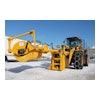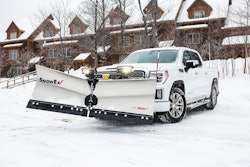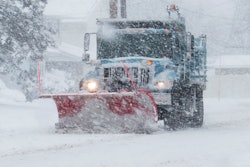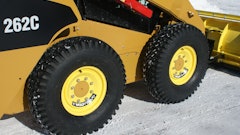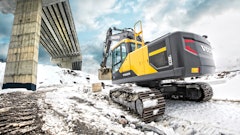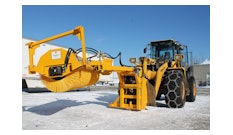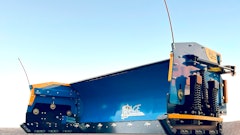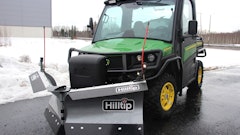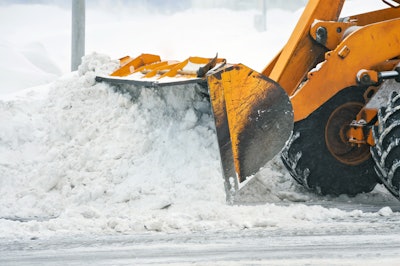
Winter isn't just coming -- it's here.
If you put much stock in the predictions of the Old Farmer's Almanac, the upcoming season is expected to experience above-normal levels of snowfall in most regions across the U.S. Which, of course, can mean a commensurate increase in demand for snow-clearing services.
That means many construction crews, lawn care providers and other contractors are turning their attention towards managing the oncoming snow, even while navigating the challenges of the current market. Routing technology is critical in prioritizing service and configuring how to handle it best. Some properties have contracts that require different work. Some businesses might need to be cleared before a certain time. Municipalities may have rules about where or how snow can be piled up. Some need more frequent service to keep snow levels at a certain height, which may require crews to return to the same site multiple times. Keeping track of these needs depending on varying degrees of snowfall can be challenging, so having a schedule configured with routing software that helps prioritize needs and add dispatch visibility is imperative. Even in non-emergent snow removal, routing technology minimizes unnecessary travel, reducing expenses like gas consumption, excess mileage on equipment, maintenance costs, resource allocation and other costs across a company's bottom line.
Plowing Through the Driver Shortage
Over the past few years, nearly every industry has experienced difficulties attracting, hiring and retaining a reliable workforce. Even as labor challenges directly stemming from the COVID-19 pandemic may finally be easing, snow removal has a history of employee churn. The physical demands of the job combined with constant exposure to extreme weather conditions can deter many from pursuing or remaining in this line of work.
The proof is in recent reporting nationwide. The Illinois Department of Transportation, municipality spokespeople in Massachusetts, and public works leadership in New York are all reporting snowplow driver shortages heading into this winter.
While putting hiring and retention programs in place is important, it's equally important to maximize utilization of your employee headcount. Technology, particularly technology that hones in on automating and optimizing existing workflows, can help snow removal crews accomplish more work, even when operating with fewer employees.
For example, scheduling features within a software platform can help facilitate accurate task and resource allocation. It optimizes crew assignments, ensuring that available manpower is used effectively, mitigating the need for excessive staffing.
Here's a tip. If you're looking to integrate scheduling software alongside your operations, take some steps to ensure you set your business up for success. Review schedules from previous seasons, particularly those you took on with a skeleton crew. Look for patterns in high-demand periods and try to identify roadblocks. Then, add any new customers into the optimization and readjust. With this, you can proactively adjust schedules, shift crew members based on performance, plan routes based on the starting location of equipment and figure out where to tighten schedules to make up for workforce gaps.
Staying clear of rising operational costs
According to IBISWorld, snow plowing services in the US experience higher profit margins than others in the sector. Still, rising operational costs can cut into profit margins. Although wages account for the most significant expense (32.1% in 2023), other costs like materials (rock salt prices, gas) and equipment (purchase, rent and depreciation) can put margins at risk. That's why it's important to look for areas to improve operational efficiency alongside labor improvements. And, one of the biggest opportunities for high-impact operations is through route optimization.
Many are familiar with using GPS or other navigation software to guide drivers from point A to point B. Route optimization goes a step past mere geographical mapping. Instead, it accounts for dynamic factors -- things like driver licensing, availability, traffic patterns and more -- to craft the most efficient route.
Take a scenario of unexpected, heavy snowfall. In this situation, it's likely that major commercial parking lots may be prioritized first. A dynamic routing technology can assess drivers to ensure a highly experienced driver can operate the larger equipment suited for major lots or high-traffic residential roads – or even help that larger machinery avoid smaller, tighter roads that can be problematic in inclement weather. Simultaneously, less experienced drivers and smaller vehicles can be routed to secondary roads, where urgency is slightly lower.
This type of response may seem straightforward -- though still necessary -- to regions that experience regular snowfall. But, think of what a difference it could make in areas where inclement winter weather is a rarity. Last February, Los Angeles experienced a rare snowfall, while Texas suffered from a damaging ice storm in March. Entire roadways were paralyzed by the ripple effects of the storms -- a paralysis that could be lessened by the benefits of technology-driven responses.
Using Technology to Lower Risk
Improved routing can also contribute to crew safety -- which can also translate into safety benefits for the community at large. This should be of special importance for your business, considering over 1,300 people are killed and more than 116,000 are injured in vehicle crashes on snowy roads each year. Technology systems enable efficient route planning and the risk of accidents or collisions is reduced simply as an effect of reducing windshield time.
Think of how your teams are equipped to communicate in non-emergent and emergent situations. And, if you're not sure where to start, here are a few questions to ask yourself.
● Do you have real-time visibility into crew locations, vehicles and drivers?
● Do they have access to communication channels that can answer job-related questions while on the road, launch a quick incident response, or involve first responders if necessary?
● Do you have access to real-time data, and feel confident in making decisions based on the data you're monitoring?
If the answer to any of these questions is 'no', it's probably a good idea to relook at the software you're using to run your business, before you get any busier this winter season.
Adopting technology to prepare for what you CAN control
Preparing for snow removal is easier said than done. Weather is unpredictable, and even with the best forecasting models, predictions aren’t always accurate. Even when the unexpected happens, service is expected as soon as possible. Technology can be depended on to create reliable routes quickly while organizing other aspects of your business so that you can always control what you CAN control, while minimizing stress, cost and risk around what you CAN’T control.
By adopting technology to suit your needs -- and the needs of your communities -- you can meet your business goals better in the year to come, while also helping keep roads clear and neighborhoods safe.



